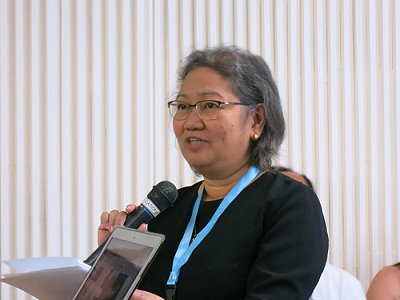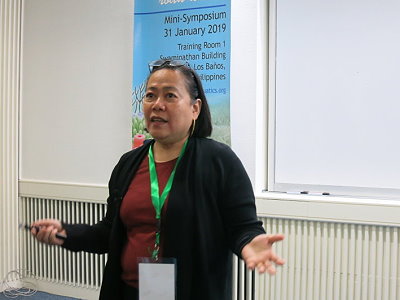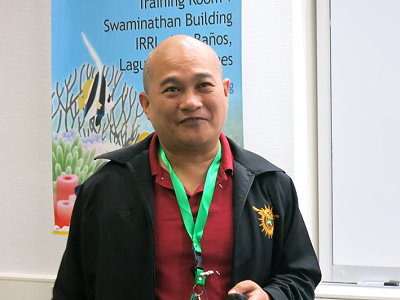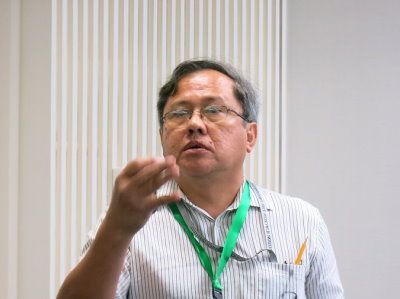 Looking ahead to the forthcoming UN Decade of Ocean Science for Sustainable Development (2021 to 2030) Quantitative Aquatics wants to share research in progress with the colleagues of IRRI, from universities and research centres in the Philippines and any interested international scholars on campus. Dr. Mary Ann Bimbao, Executive Director of Q-quatics, welcomed guests and staff to this event on 31 January 2019. She recalled the origins of FishBase, SeaLifeBase and Aquamaps and pointed to the many new possibilities these global databases had opened to ask questions and retrieve answers. The breadth of presentations gave a good indication to even more opportunities on the road ahead.
Looking ahead to the forthcoming UN Decade of Ocean Science for Sustainable Development (2021 to 2030) Quantitative Aquatics wants to share research in progress with the colleagues of IRRI, from universities and research centres in the Philippines and any interested international scholars on campus. Dr. Mary Ann Bimbao, Executive Director of Q-quatics, welcomed guests and staff to this event on 31 January 2019. She recalled the origins of FishBase, SeaLifeBase and Aquamaps and pointed to the many new possibilities these global databases had opened to ask questions and retrieve answers. The breadth of presentations gave a good indication to even more opportunities on the road ahead.
Cornelia E Nauen, chair of the Q-quatics Board of Trustees and president of Mundus maris started her talk recalling the long way from the development of the small-scale fisheries (SSF) Guidelines and their insertion into the Sustainable Development Goals (SDGs). In response to the many challenges to the future of prosperous and sustainable SSF, the SSF Guidelines spell out a range of measures largely addressed to governments with a view to adjust prevailing policies in favour of industrial fishing. But there is a lot of room for industries and civil society to complement and for scientists and research organisations to engage. This is because traditional knowledge is valuable to maintain the cultural strengths of SSF communities, but operating in a globalised environment requires new and additional knowledge and innovation, where critically engaged cooperation is much needed. The SSF academy in Senegal launched in November last year wants to develop into such a multi-stakeholder space for joint learning and co-production of new knowledge in support of implementing the Guidelines. It should develop responses e.g. to questions asked about changes in the ecosystem under conditions of overfishing and climate change and should do so developing methods that facilitate communication between people with very different backgrounds. Such work can benefit from the immense pool of information and significant analysis capacity provided by the global databases managed by Q-quatics, but need interfaces provided through collaboration with experts. Click here for the slides.
 Dr. Maria Lourdes (Deng) Palomares, Senior Scientist and Project Manager, Sea Around Us, and Science Director, Q-quatics, Philippines, gave insights into "A Global Assessment of the Status of Exploited Marine Populations". A preliminary assessment of the status of 1320 fish and invertebrate populations (or ‘stocks’) of 483 species exploited by fisheries in 232 Marine Ecoregions (MEs) overlapping with the Exclusive Economic Zones (EEZs) of 218 countries and their overseas territories was performed using the CMSY method applied to annual catches (1950-2014) reconstructed by the Sea Around Us. Work is going on to improve the priors and thus the robustness of this powerful methods suited also for data-poor stocks.
Dr. Maria Lourdes (Deng) Palomares, Senior Scientist and Project Manager, Sea Around Us, and Science Director, Q-quatics, Philippines, gave insights into "A Global Assessment of the Status of Exploited Marine Populations". A preliminary assessment of the status of 1320 fish and invertebrate populations (or ‘stocks’) of 483 species exploited by fisheries in 232 Marine Ecoregions (MEs) overlapping with the Exclusive Economic Zones (EEZs) of 218 countries and their overseas territories was performed using the CMSY method applied to annual catches (1950-2014) reconstructed by the Sea Around Us. Work is going on to improve the priors and thus the robustness of this powerful methods suited also for data-poor stocks.
Dr. Peter Sorensen, Professor, Department of Fisheries, Wildlife and Conservation Biology, University of Minnesota, USA, talked about "A new analysis of global freshwater finfisheries describes strongly divergent trends between well-developed and less developed countries" making a very convincing plea for much greater attention to very valuable, yet understudied freshwater resources.
 Dr. Benjamin M. Vallejo Jr., Associate Professor, University of the Philippines-Diliman, Qquatics Board member, Philippines, gave a very insightful talk about "The Safe Risk Area Ports Initiative for Ballast Water Management in ASEAN". The Safe Risk Area for international ports in ASEAN was proposed by the ASEAN ministers of transportation in July 2018 as a compliance to the International Ballast Water Convention of the International Maritime Organization. This Convention is now part of domestic law of IMO member nations with 77 countries ratifying the treaty. Dr. Vallejo described various approaches to determining the SRA using marine biodiversity baseline information provided by biological databases.
Dr. Benjamin M. Vallejo Jr., Associate Professor, University of the Philippines-Diliman, Qquatics Board member, Philippines, gave a very insightful talk about "The Safe Risk Area Ports Initiative for Ballast Water Management in ASEAN". The Safe Risk Area for international ports in ASEAN was proposed by the ASEAN ministers of transportation in July 2018 as a compliance to the International Ballast Water Convention of the International Maritime Organization. This Convention is now part of domestic law of IMO member nations with 77 countries ratifying the treaty. Dr. Vallejo described various approaches to determining the SRA using marine biodiversity baseline information provided by biological databases.
Dr. Lucas Brotz, Cnidaria Scientist of Q-quatics, Philippines, presented "Jellyfish and Humans – the Big Picture". Reports of jellyfish interfering with human activities are on the rise, resulting in substantial economic losses for several industries. But are jellyfish blooms actually increasing, or are we just noticing more of them as they get in our way? Demand for jellyfish as food for humans is growing, and some have suggested that perhaps we can fish our way out the problem. A number of other counter-measures have also been developed to try and control jellyfish populations, with mixed results. Preventing a more gelatinous future appears unlikely, so adaptation may be our best bet.
 Rodolfo B. Reyes, Jr., Research Associate of Q-quatics, Philippines, presented a talk titled "The Use of FishBase and SeaLifeBase Species Identification Tools in the Analysis of Marine Megafauna Using Underwater Videos". Species identification is a tedious task, requiring many hours of training and experience to learn and attain a level of proficiency useful in research. FishBase and SeaLifeBase have species identification tools using various approaches to cater to users with different levels of proficiency.
Rodolfo B. Reyes, Jr., Research Associate of Q-quatics, Philippines, presented a talk titled "The Use of FishBase and SeaLifeBase Species Identification Tools in the Analysis of Marine Megafauna Using Underwater Videos". Species identification is a tedious task, requiring many hours of training and experience to learn and attain a level of proficiency useful in research. FishBase and SeaLifeBase have species identification tools using various approaches to cater to users with different levels of proficiency.
The Q-quatics – University of Western Australia collaboration on the analysis of marine megafauna applies the Quick Identification Tool to identify fish and non-fish species in underwater videos. The talk briefly described the process and the challenges in species identification in underwater videos. It presented the features added in the Quick ID tool for this work and discussed the initial experience of Q-quatics staff.
The last talk was by Dr. Nicolas Bailly, Taxonomic Coordinator, Q-quatics, Philippines, about "The FAO Global Record of Stocks and Fisheries: Its Role in SDG14, and the Links with FishBase and SeaLifeBase". The Sustainable Development Goals are subdivided in targets for which indicators were developed.
 As a UN Agency, FAO and its Fisheries and Aquaculture Department is responsible for four targets dedicated to fisheries. In particular, the SDG14.4: “By 2020, effectively regulate harvesting and end overfishing, illegal, unreported and unregulated fishing and destructive fishing practices and implement science-based management plans, in order to restore fish stocks in the shortest time feasible, at least to levels that can produce maximum sustainable yield as determined by their biological characteristics”. And its indicator: “Proportion of fish stocks within biologically sustainable levels”. In order to monitor this indicator, FAO developed a dedicated Virtual Research Environment (VRE) in the D4Science platform during the BlueBridge Horizon 2020 European project, a follow up component of the iMarine initiative.
As a UN Agency, FAO and its Fisheries and Aquaculture Department is responsible for four targets dedicated to fisheries. In particular, the SDG14.4: “By 2020, effectively regulate harvesting and end overfishing, illegal, unreported and unregulated fishing and destructive fishing practices and implement science-based management plans, in order to restore fish stocks in the shortest time feasible, at least to levels that can produce maximum sustainable yield as determined by their biological characteristics”. And its indicator: “Proportion of fish stocks within biologically sustainable levels”. In order to monitor this indicator, FAO developed a dedicated Virtual Research Environment (VRE) in the D4Science platform during the BlueBridge Horizon 2020 European project, a follow up component of the iMarine initiative.
Since the beginning, FishBase and SeaLifeBase have the capacity to record information at stock level. This capacity is hindered by a lack of consensus taxonomy about stocks reported by countries and Regional Fisheries Management Bodies. This new FAO standard should help a lot to create records beyond the European and North American stocks. In return, GRSF could benefit from other types of information from FB and SLB.
The final part gave free range to questions from the audience. Quite a few participants made intensive use of this interactive possibility. The unanimous sens at the end of the event was - congrats to the Q-quatics team and its guest speakers for a morning well spent together.








